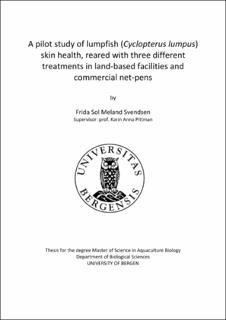| dc.description.abstract | Biological delousing by the means of deploying cleanerfish is one of the methods applied in Atlantic salmon aquaculture to combat the sea lice (lepeophtheirus salmonis) infestation problem. The method is based on the natural behaviour of certain fish species exhibiting mutualistic cleaning behaviour, to then graze on the parasite on the salmon. The lumpfish (Cyclopterus lumpus) is one such cleanerfish species. Lumpfish have been used commercially as a cleanerfish since mid-2010s, and the hatchery production of eggs from wild caught broodstock has become an industry of its own. The peak in production volume was in 2019 when over 42 million lumpfish were hatchery produced and deployed in Norwegian Salmon cages. Extensive research has however shown that the lumpfish health and welfare are often poorly maintained during their time at sea, and modest estimations of mortality is 46 %, and observations of 100 % have also been made. The industry has grown tremendously in just a few years, and thus the research regarding how to maintain the species health and welfare have not caught up to speed. As long as there is a lack of knowledge regarding basic lumpfish physiology, the welfare of the cleanerfish will not improve. To get a better understanding of the factors influencing lumpfish health, two preliminary research projects consisting of two land-based (Agder and Austevoll) and one sea-based (Fitjar), experiments were conducted during 2020. In these experiments the lumpfish were reared with the different treatments natural kelp, plastic kelp, and no kelp, to investigate if the treatments had an influence on the skin health of the lumpfish. Lumpfish from all three experiments (n=140) were sampled, and skin analyses were applied through mucosal mapping. This is an objective and quantitative measure of skin health, applied to a range of fish species. Mucous cell mean area (MA), volumetric density (VD), and defence activity (DA) exhibited by the mucous cells in the lumpfish skin were then calculated, and found to be within the range of other species. No significant differences between the different treatments in the experiments were found, but significant differences within experiments between sampling dates were observed. The results also show an increase in the mean area of the mucous cells and increased defence activity with increasing exposure to particles and pathogens in the water. Additionally, microbiological analyses were obtained from researchers at BIO (UiB), and the relative abundance (RA) of different bacterial taxa were measured again MA, VD and DA, of the lumpfish skin, however few significant correlations were found. The present study is the first of its kind to scientifically use natural kelp as a substrate for lumpfish in commercial salmon production and several commercial like systems. This research is an important element in establishing a baseline for lumpfish health, which is currently missing. | |
